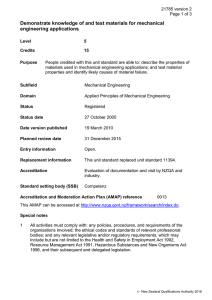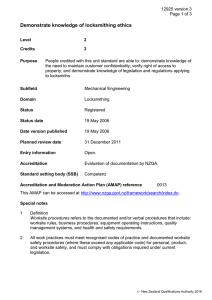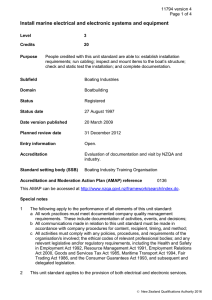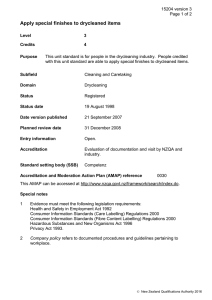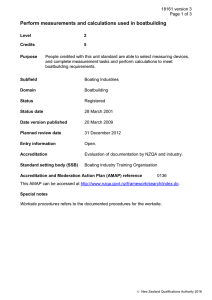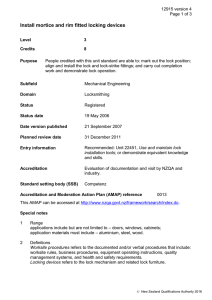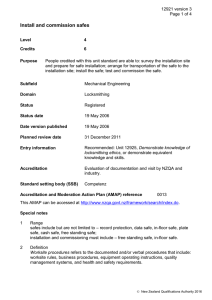Use and maintain lock installation tools
advertisement
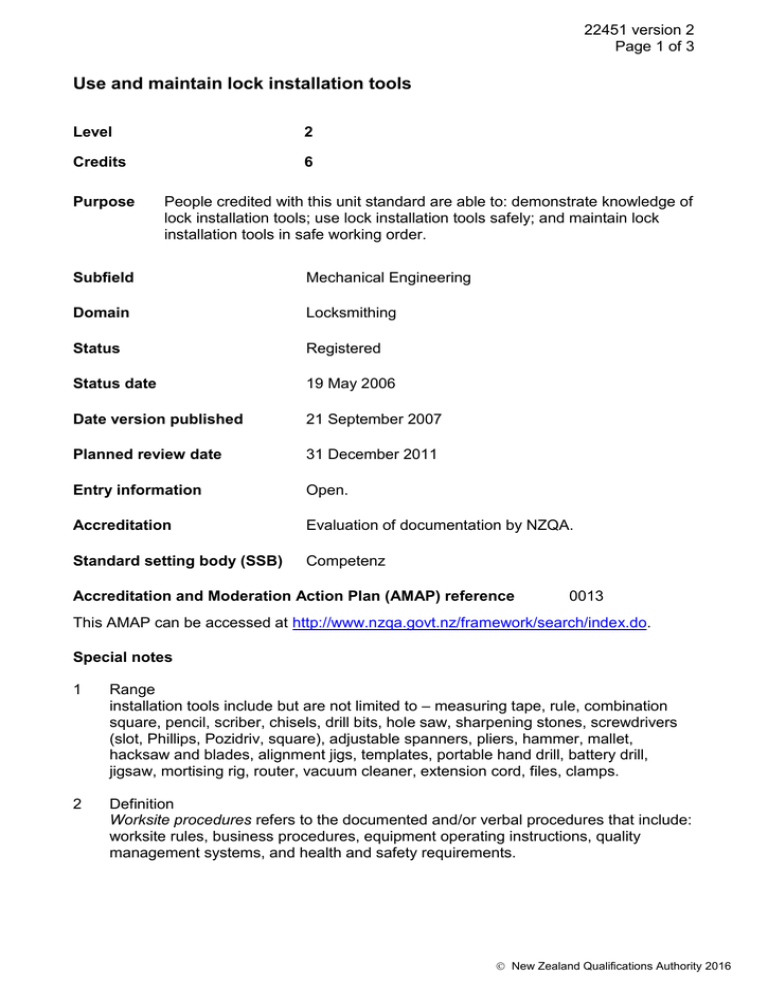
22451 version 2 Page 1 of 3 Use and maintain lock installation tools Level 2 Credits 6 Purpose People credited with this unit standard are able to: demonstrate knowledge of lock installation tools; use lock installation tools safely; and maintain lock installation tools in safe working order. Subfield Mechanical Engineering Domain Locksmithing Status Registered Status date 19 May 2006 Date version published 21 September 2007 Planned review date 31 December 2011 Entry information Open. Accreditation Evaluation of documentation by NZQA. Standard setting body (SSB) Competenz Accreditation and Moderation Action Plan (AMAP) reference 0013 This AMAP can be accessed at http://www.nzqa.govt.nz/framework/search/index.do. Special notes 1 Range installation tools include but are not limited to – measuring tape, rule, combination square, pencil, scriber, chisels, drill bits, hole saw, sharpening stones, screwdrivers (slot, Phillips, Pozidriv, square), adjustable spanners, pliers, hammer, mallet, hacksaw and blades, alignment jigs, templates, portable hand drill, battery drill, jigsaw, mortising rig, router, vacuum cleaner, extension cord, files, clamps. 2 Definition Worksite procedures refers to the documented and/or verbal procedures that include: worksite rules, business procedures, equipment operating instructions, quality management systems, and health and safety requirements. New Zealand Qualifications Authority 2016 22451 version 2 Page 2 of 3 3 All work practices must meet recognised codes of practice and documented worksite safety procedures (where these exceed any applicable code) for personal, product, and worksite safety, and must comply with current legislation. 4 Legislation relevant to this unit standard includes but is not limited to the Health and Safety in Employment Act 1992. 5 An electrical safety tag is affixed to an appliance after it has been given a safety inspection by a trained person. This is a requirement under the Electricity Regulations. AS/NZS 3760:2003, In-service safety inspection and testing of electrical equipment is the standard that contains the frequency of inspection, and the tests and standards involved for different appliance types and conditions. Elements and performance criteria Element 1 Demonstrate knowledge of lock installation tools. Performance criteria 1.1 Use of tools is described in terms of the work operations to be completed. 1.2 Care and maintenance of tools are described according to good industry practice. 1.3 Safe use of tools is described. Range includes but is not limited to – hazards and risks, injury to users and others, damage to materials and tools. Element 2 Use lock installation tools safely. Performance criteria 2.1 Suitable safety and personal protective equipment is selected and used according to Occupational Safety and Health requirements and, worksite procedures. Range may include but is not limited to – signs, barriers, masks, goggles or safety glasses, earmuffs or plugs, vests, hard hats, gloves, knee pads, safety boots, warning signs and tapes, fire extinguisher, first aid kit, residual current devices. 2.2 Tools are selected to meet identified job requirements. 2.3 Tools are used in the manner and purpose for which they were designed. New Zealand Qualifications Authority 2016 22451 version 2 Page 3 of 3 2.4 Tools are used to complete the operation without injury to the user or bystander, and without damage to materials. Element 3 Maintain lock installation tools in safe working order. Performance criteria 3.1 Cutting edges are ground and sharpened to give maximum cutting efficiency. 3.2 Tools are maintained in working order, clean, and free of rust. 3.3 Tools are stored in an appropriate location and manner, according to worksite procedures. 3.4 Portable power tools are visually inspected for safety and tagged if found unsafe. Range 3.5 current electrical safety tag, undamaged cord, appliance not broken, danger and/or out of order tag. Damaged and broken tools are either repaired or replaced according to worksite procedures. Please note Providers must be accredited by NZQA, or an inter-institutional body with delegated authority for quality assurance, before they can report credits from assessment against unit standards or deliver courses of study leading to that assessment. Industry Training Organisations must be accredited by NZQA before they can register credits from assessment against unit standards. Accredited providers and Industry Training Organisations assessing against unit standards must engage with the moderation system that applies to those standards. Accreditation requirements and an outline of the moderation system that applies to this standard are outlined in the Accreditation and Moderation Action Plan (AMAP). The AMAP also includes useful information about special requirements for organisations wishing to develop education and training programmes, such as minimum qualifications for tutors and assessors, and special resource requirements. Comments on this unit standard Please contact Competenz qualifications@competenz.org.nz if you wish to suggest changes to the content of this unit standard. New Zealand Qualifications Authority 2016

